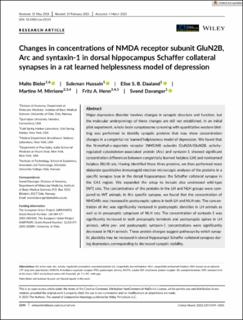Changes in concentrations of NMDA receptor subunit GluN2B, Arc and syntaxin-1 in dorsal hippocampus Schaffer collateral synapses in a rat learned helplessness model of depression
Bieler, Malte; Hussain, Suleman; Daaland, Elise; Mirrione, Martine M.; Henn, Fritz A.; Davanger, Svend
Peer reviewed, Journal article
Published version
Permanent lenke
https://hdl.handle.net/11250/2833781Utgivelsesdato
2021Metadata
Vis full innførselSammendrag
Major depressive disorder involves changes in synaptic structure and function, but the molecular underpinnings of these changes are still not established. In an initial pilot experiment, whole-brain synaptosome screening with quantitative western blotting was performed to identify synaptic proteins that may show concentration changes in a congenital rat learned helplessness model of depression. We found that the N-methyl-D-aspartate receptor (NMDAR) subunits GluN2A/GluN2B, activityregulated cytoskeleton-associated protein (Arc) and syntaxin-1 showed significant concentration differences between congenitally learned helpless (LH) and nonlearned helpless (NLH) rats. Having identified these three proteins, we then performed more elaborate quantitative immunogold electron microscopic analyses of the proteins in a specific synapse type in the dorsal hippocampus: the Schaffer collateral synapse in the CA1 region. We expanded the setup to include also unstressed wild-type (WT) rats. The concentrations of the proteins in the LH and NLH groups were compared to WT animals. In this specific synapse, we found that the concentration of NMDARs was increased in postsynaptic spines in both LH and NLH rats. The concentration of Arc was significantly increased in postsynaptic densities in LH animals as well as in presynaptic cytoplasm of NLH rats. The concentration of syntaxin-1 was significantly increased in both presynaptic terminals and postsynaptic spines in LH animals, while pre- and postsynaptic syntaxin-1 concentrations were significantly decreased in NLH animals. These protein changes suggest pathways by which synaptic plasticity may be increased in dorsal hippocampal Schaffer collateral synapses during depression, corresponding to decreased synaptic stability.

